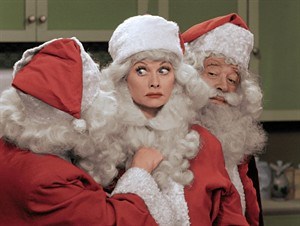
This image released by CBS shows Lucille Ball, center, dressed as Santa Claus in a colourized "I Love Lucy Christmas Special" airing on Friday, Dec. 20, on CBS. (AP Photo/CBS)
December 19, 2013 - 9:12 AM
A white Christmas is one thing, but a black-and-white Christmas?
Not in today's age of digital, on-demand television.
Hence CBS's latest attempt to bring colour to one of TV's most beloved black-and-white series, "I Love Lucy."
Two episodes from the 1950s sitcom, the little seen "Christmas Episode," as well as "Lucy's Italian Movie" (often referred to as the grape stomping episode), are being bundled into a new Christmas package Friday night (check local listings).
Over 60 years since it premiered, "I Love Lucy" (1951 to '57) still ranks with "Seinfeld" at the top of most "Best Ever" TV sitcom lists. Star Lucille Ball was known as "TV's zany redhead," but only ever appeared in black and white during the entire run of that series. Her Cuban bandleader husband and co-star, Desi Arnaz, kept making "Lucy-Desi" hours right up until their 1960 split.
"I Love Lucy" is still considered the blueprint for every sitcom since. One reason is that the show (taped in front of a studio audience) was always shot on movie grade 35mm film instead of videotape, allowing negatives to be preserved and episodes to be rerun over and over again. As popular as it was during its original run, millions more saw it in reruns in the decades since it went out of production.
Network television, however, did not fully switch over to colour broadcasts until 1966. Some popular series straddle both the black-and-white and colour eras, including "Bewitched," "I Dream of Jeannie," Gilligan's Island" and "The Andy Griffith Show."
Attempts to colourize the original "Lucy" series have been tried before. Thirty years ago, a Toronto-based company run by Wilson Markle, a Canadian engineer considered the father of colourization, attempted to add hues to Laurel & Hardy shorts from the '30s.
Purists turned purple. A report that CNN and TCM founder Ted Turner wanted to colourize "Citizen Kane" drew cries of outrage throughout the film community. Popular critics Gene Siskel and Roger Ebert branded it "Hollywood's New Vandalism."
I was a rookie reporter for TV Guide during this first wave of computer-generated colourization. One of my very first assignments was to ask Laurel & Hardy producer Hal Roach — then 91 — what he thought of the process.
"Comedy doesn't need colour," huffed Roach, who then asked if I read "the funnies" — newspaper comics which back then ran mostly without colour.
"Five days a week, you read the comics in black and white," said Roach. "On Sunday, you see them in colour. Do you laugh just on Sunday, or every day?"
Around that same time, I attended a TV critics' press tour in Los Angeles where Lucille Ball was attempting what turned out to be an unfortunate comeback. The series, "Life with Lucy," only lasted a few months. (Ball passed away in 1989.)
Still, I was able to ask the TV legend if she had seen any colour tests of her old series. Ball said she wasn't impressed. "They didn't even give me red hair!" she complained.
They get the hair right on the episodes shown Friday. The segments were done by two separate companies: West Wing Studios did the Christmas scenes, which seem more realistic. (They were also responsible for colourizing several Three Stooges shorts a few years ago.) Legend Films handled the "Italian Movie" transfer.
In both instances, according to CBS, attempts were made by art directors working the digital colour transformations to use a palette in keeping with Technicolor films shot during the '50s. Hence Lucy and her neighbour Ethel Mertz's bright red lipstick.
Viewers may wonder if the Ricardos' New York apartment really was that drab. An actual 1951 film clip, shot on a 8mm home movie camera from a studio audience member in the bleachers, recently surfaced on YouTube. It shows the living room set really did have those dull, greyish-beige walls and grey doors, giving the modern day colourizers less of a background challenge.
The use of colour in the Christmas episode also stands out because it is used more sparingly. This was essentially a "clip" show, with the Ricardos (Lucy and Ricky) and their neighbours, the Mertzes (Vivian Vance and William Frawley), flashing back to earlier episodes of the series. They mainly tell the story of the arrival of Little Ricky (Keith Thibodeaux, now 63 and the only surviving member of the original cast).
The set-up, showing the families decorating the tree, is in colour, while the flashback clips remain in black and white.
The Christmas episode, shot in 1956, was deemed too seasonal for syndication and pulled from the rerun package. It went unseen for many years until CBS found a print and colourized it for a 1990 airing. Friday's special is a brand new, hi-def, attempt to bring Lucy into the digital age.
___
Bill Brioux is a freelance TV columnist based in Brampton, Ont.
News from © The Canadian Press, 2013